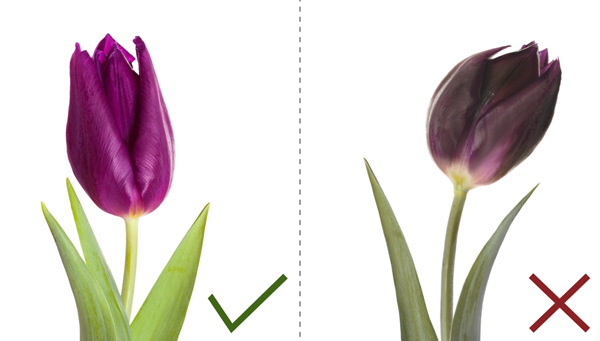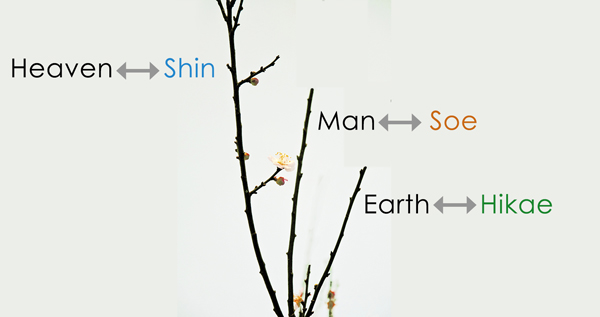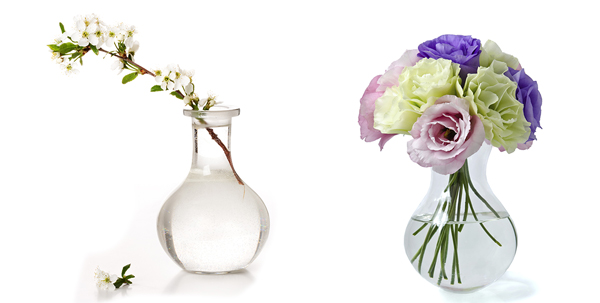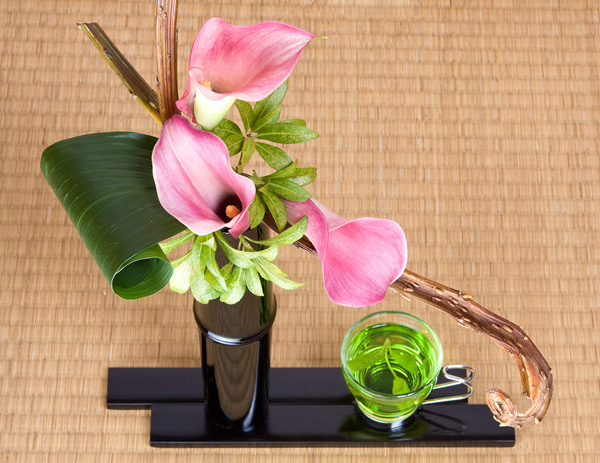
One of the most natural, aesthetic, simple, and pleasing floral arrangements, ikebana focuses on the harmony between the elements and their connection with nature. It comprises beautiful flower arrangements and is characterized by the principles of minimalism, simplicity, asymmetry, structure, shape, line, peace, nature, humanity, form, and aesthetics.
An Introduction to Ikebana
The origins of ikebana lie in the ancient Japanese Buddhist practices and rituals of arranging flowers to invoke nature and please the gods. The ikebana that we know today, first evolved around the mid-1500s. Literally translated, it means ‘flowers brought alive’, and is a stunning art form of flower arrangement that points towards heaven as a sign of faith. Its purpose is to establish a harmonious relationship between the plant material, the container, and the background. A point to remember is that the arrangement should focus on achieving a fine balance between lines, color, and simplicity, to reflect the beauty of nature.
Ikebana is expected to be followed in such a way that it can be admired from all angles, which is why the elements should be carefully arranged in a three-dimensional view.
This structure comprises three elements – heaven, man, and earth. Heaven is the main element and lies in the center. The second element is Man; it is two-thirds the height of the primary stem and is placed beside the same. The last element is Earth; it is the shortest stem and is placed in front of the primary stem or opposite the secondary stem. Remember to place these elements such that they appear to be originating from one source.
General Tips for Ikebana
Try to maintain sufficient space between the flowers, leaves, and stems. Fill any gap, if present, considering the color and effect of the elements.
Always draw or sketch the arrangement you wish to create. Once you are clear with what you want to display, choosing the elements and arranging them becomes easier. This technique of laying out the desired arrangement on paper is termed as ‘kakeizu’ in Japanese.
Ikebana Vase Selection
Containers play a crucial role in the flower arrangement, and there are different types one can choose from. The most common ones include vases that are small and shallow or tall and slender.
When flowers are arranged in a shallow vase, it is called moribana. In this style, flowers can be arranged upright or in a slightly inclined manner. Arrangements in a tall vase are called nagaire, which usually includes fewer elements.
Various types of containers can be used for this arrangement, and the choice varies as per the season. For instance, summer demands the use of lovely baskets, while winter demands the use of metal containers. In spring and autumn, the use of clay pots or containers is more popular.
Flowers for Ikebana
While arranging the flowers, remember their significance. If you use fully-bloomed flowers, the arrangement represents the past. Partially-bloomed flowers represent the present. Flowers that are still in the bud phase, apparently represent the future.
Flowers should always be fresh – really fresh, because the freshness of the blooms adds to the charm. Avoid using slightly wilted, diseased or infested flowers as the aesthetic appeal of the arrangement is lost.
Fresh flowers have bright colors with thick and vivid petals, and the leaves and stems are bright green as well. Once they are severed from their roots, they start dehydrating. Therefore, place them in water before they start wilting.
Prior to arranging, spray water on the flowers using a atomizing spray. Then, leave them to air dry in a ventilated area for a few weeks.
An ikebana arrangement primarily uses 3 types of large flowers that possess individual significance. Peonies symbolize riches. Chrysanthemums have a special place in Japanese culture. They last long, and symbolize royalty, longevity, and the sun. Lotuses symbolize purity and immortality.
Besides peonies, lotuses and chrysanthemums, camellia, magnolia, wisteria, azalea, tulips, narcissus, forsythia, orchids, rose, aster, jasmine, and iris are also used.
Some artificial elements like flowers, stems, branches, pods, etc., are added to enhance the appeal. Artificial/Filler flowers are termed ‘jushi’, and they provide the necessary finesse to the final structure.
While selecting filler flowers, consider the overall look of the arrangement. Thin stems and branches would demand large fillers, while smaller blossoms go well with thicker leaf designs.
Showy blossoms lend a balance and attractiveness to the overall look.
A natural balance between the elements is achieved when you use odd number of flowers – for both, the actual flowers as well as jushi.
Stems for Ikebana
The basic design features 3 stems, namely, ‘shin’, ‘soe’, and ‘hikae’. ‘Shin’ is the longest stem, used to represent the element of Heaven. It is followed by ‘soe’, that usually represents Man, while the ‘hikae’ is the shortest, representing Earth. Every stem should be visible in the final arrangement, particularly the ‘shin’.
Imagine a vertical line in the middle of the container, around which you will arrange the elements. Place the shin at an angle of 15 degrees to the left of this line. Place the soe at an angle of 45 degrees towards the left. The hikae leans to the right of the line, in front of the shin, at an angle of 75 degrees. The resultant frame is shaped like a scalene triangle.
Cut the stems to around 6 inches long and discard excess foliage. To add volume or to give them shape, consider tying them to a hanger with dental floss, either individually or with a rubber band.
Branches for Ikebana
A variety of branches are used in this arrangement for visual enhancement. They create the right balance between height and length and enhance the flow of the structure.
Different types of twigs and flowering branches are used in ikebana, in vertical and horizontal angles. The most commonly-used flowering branches include plum, peach, and cherry. While plum blossoms symbolize hope and strength in the face of adversity, cherry blossoms symbolize mortality.
Leaves in Ikebana
Leaves play a vital role in Ikebana; there are certain arrangements that solely encompass leaves of varying shapes and sizes along with simple and ornamental stems.
Arranging leaves in this art form is particularly challenging, given the wide variety of designs. Arrangements vary with different leaf sizes. Also, leaves are trimmed according to their use along with certain elements.
Preferably, pair larger leaves with small, single blossoms, and large flowers with a multitude of small leaves. This is necessary to restore balance and establish an aesthetic appeal.
The importance of leaves is manifested in the fact that they are always placed above water. While arranging, if you find that leaves are getting submerged, either trim them off completely, or trim the stems in such a way that the leaves are clearly visible.
The Role of Water in Ikebana
Do not allow leaves to submerge in the water as they rot and give rise to bacteria. Cut the stems diagonally, they absorb water better. Always keep the flowers in water. While arranging, immerse them in a bucket of water until you use them in the container filled with a little water. It is not necessary to submerge branches and twigs in the water.
The elements will require periodic watering to remain fresh. Spray water on the stems, flowers, and leaves regularly. Water requirements change as per the flowers used. Retaining the freshness is very important for ikebana.
Accessories for Ikebana
Artificial elements include bamboo shoots, pine leaves, small canes, sticks, dried grass, decorative leaves, crotons, paper flowers, sword-like leaves, fruit pods, crosspieces, and more.
The base or holder, also known as kenzan, consists of many sharp pins on which the flowers and stems are attached. Foam or metal holders can also be used.
Traditionally, kenzan are not tightly secured to the vase, unless one uses plant or fruit matter. Nowadays, though, glue and floral tapes are used to fix the kenzan to the container. Once fixed, the container may be filled with water, sufficient to cover the kenzan.
Different Ikebana Arrangements
One of the simplest arrangements, this style involves the use of a tall stem, accompanied by two smaller stems.
Traditionally an exhibit at tea ceremonies, this style involves using bamboo, ceramics, and glass baskets, with rustic, natural elements. Remember that this style uses no extra props.
This style always uses standing flowers, irrespective of the container. No flower or blossom is represented as low-lying. The essence of the arrangement is to enhance the beauty of the flowers in vertical patterns.
Also called heika/shoka, it is the most elementary form of flower arrangement. It uses a slender, tall vase, small blossoms, and thin, ornamental stems and branches, tied together at the mouth of the jar, arranged in vertical formations. It highlights the natural elegance of the elements.
This arrangement incorporates all the elements – flowers, stems, branches, twigs, ornamental designs, pods, and many more. Only a simple and minimalistic appeal has to be maintained.
Samples for Ikebana
Choose a shallow container. Line with floral foam/pin holder. Insert a flower stem at the center, tilted at 45 degrees. Insert a stem with leaves. You may enhance with short, artificial leaves or twigs. Fill the container with water, and you’re done.
Place small pin holders in a shallow tray and pour water. Trim leaves in a delightful pattern and arrange as per the Ikebana structure. Choose attractive flower heads and arrange them in front of the leaves. Place croton branches (if needed) behind the leaves and admire your handiwork.








































